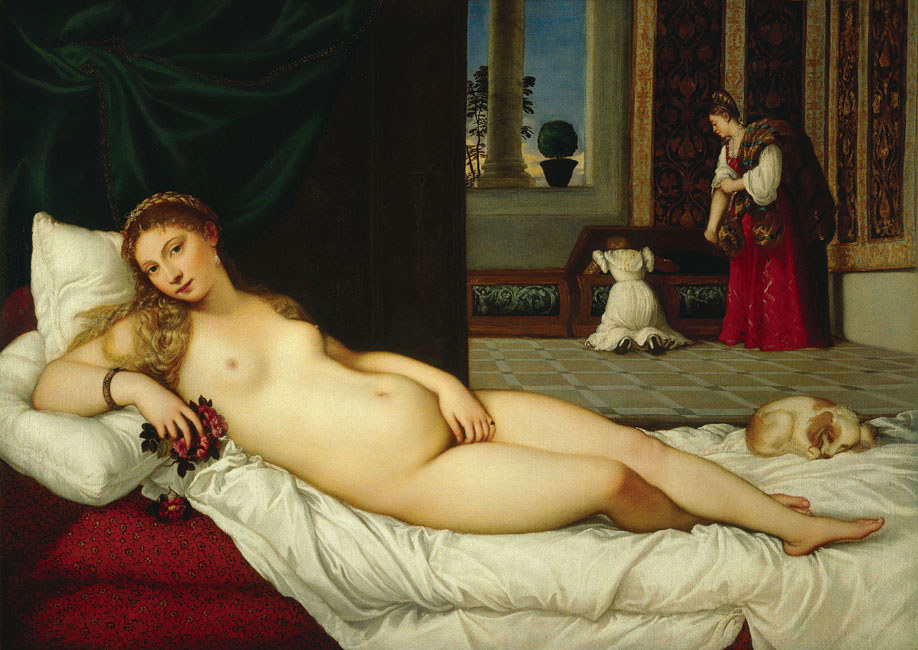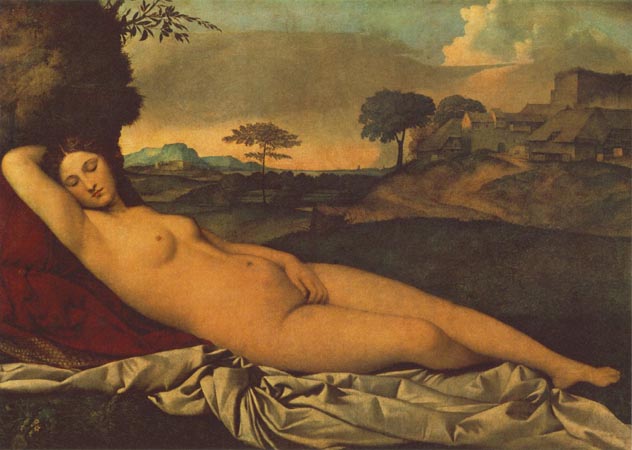
Titian's Venus of Urbino
Extracts
"These intertwined themes of possession of the beautiful woman and the creation of her image permeated the Renaissance conception of the female in art. Whereas the ancients asserted that whoever can best depict a beautiful woman deserves to have her, Renaissance people might transfer this privilege of possession from the maker to the owner of the image. This in turn raises questions of patronage and the intended use of Titian's images of women. In some notable instances, the voices of the first owners and viewers of Titian's women may still be heard; we are obliged to listen to them as we view his paintings. Listening, we can no longer dismiss Titian's work as pornography or even as erotica nor summarize it as the display of the passive female object offered to the active male beholder." ...
The Venus of Urbino, like her prototype in Dresden, is a depiction of female sexuality, powerful, to be sure, but finding (in fact, demanding) appropriate fulfillment in marriage....

...
Venus' direct gaze has been characterized as an "unambiguous sexual invitation" by one wishful art historian. The invitation is germane to the matrimonial context, however, and in no way promiscuous. We may recall the forthright glance of "Profane Love," likewise addressed to her husband. Although modern viewers may be discomforted when caught in the act of looking --"caught in the act of voyeurism" -- Renaissance viewers would find such attention in keeping with the expectation, endorsed by Leon Battista Alberti, that a character would acknowledge beholders with a glance or a gesture. The modern critics' presumption of Venus' impropriety is a misconception that Edouard Manet's Olympia popularized.
Manet's protagonist is a prostitute --not a courtesan, as some critics have assumed Titian's Venus to be, but more the nineteenth-century equivalent of the Renaissance meretrice. The distinction among these categories were not mere niceties in Renaissance Venice. In general, a courtesan was distinguished from a meretrice (prostitute) or puttana (whore) by her class (or class pretensions), by her superior economic status, and by the social status and (limited) number of her lovers. As a concomitant of these social and "romantic" aspects of her position, a courtesan might also claim exemption from sumptuary laws concerning dress and legislation regarding where she might live.
Available to all comers and surrounded by explicit references to her trade, Olympia receives her next john --by implication, the beholder. But what of her Venetian predecessor? In a domestic setting and without Cupid or other explicitly mythological trappings, she may be a goddess or a mortal. If mortal, and even if a courtesan or mistress, she is nonetheless presented with clear indications of social status, and these are merely the trappings that serve to confirm what each woman reveals about herself in her expression and gestures: Olympia is hardened, cynical, blasée; Venus is confident, intelligent, alert. Whatever may have motivated Manet's alterations to Titian's composition --including the imposition of a new name-- the Frenchman's changes imply that he understood the Venetian woman to be a (culture) goddess who required not only modernization but profanation, not only emulation but denigration.
Giorgione's Sleeping Venus [Dresden Venus].
....
Titian took from Giorgione's Venus both the pose and the gesture. Now that Titian's goddess has awakened to behold her beloved directly, psychological tension established by the sexual demand explicit in her gaze has replaced the self-aborption of the Dresden Venus. The Venus of Urbino adds assertiveness to independence: fully sentient, cognizant, and self-aware, she reclines in a well-furnished, modern (sixteenth-century) bedroom and addresses her sexual power forthrightly to the beholder. Possibly for these psychological reasons --all consistent /p. 154: with Renaissance beliefs about the insatiable sexuality of women --some scholars have seen in her a pejorative implication of Guidobaldo's pithy label, "the nude woman": if she's not a virgin, she most be a whore.
full article:
http://employees.oneonta.edu/farberas/arth/arth213/Titian_Venus_urbino.html
1 comment:
thanks this helped alot!
Post a Comment